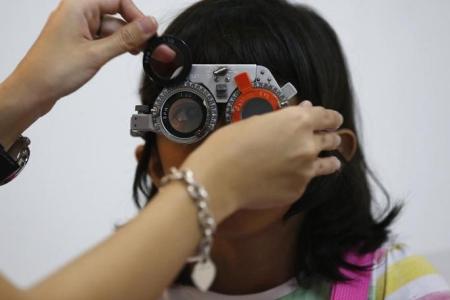More cases of high myopia seen in Singapore
Ms Candice Chong started wearing glasses when she was four.
By the time she was 13, she had a lens prescription of around minus 10 dioptres (1,000 degrees) for each eye, and her myopia continued to worsen throughout her teenage years to reach around 2,000 degrees in each eye.
High myopia is typically defined as short-sightedness of over minus 5 dioptres (500 degrees), though some experts argue that it should be minus 6 dioptres (600 degrees) and above.
Excessive eye growth, or elongation of the eyeball, causes myopia. In some cases, myopes like Ms Chong, now 43, suffer from pathologic myopia, which in turn causes degenerative changes to the back of the eye.
“Normal eyeballs are like fishballs, but for people like me, my eyeballs are the shape of a sausage... very stretched, elongated... and more fragile overall,” said Ms Chong.
She started experiencing complications due to her high myopia not long after she turned 20.
First, it was glaucoma. Then, she had cataract surgery in one eye, and then the other, in her 30s. In 2023, she underwent surgery to prevent a retinal tear in her left eye.
Singapore is seeing more and more highly myopic adults, and the number is expected to grow in the coming decades.
“We cannot see the problem now, but it will come,” said Professor Saw Seang Mei, the Distinguished Wallace Foulds Professor at Duke-NUS Medical School.
“Pathologic myopia, a rising problem, will be a leading cause of low vision in Singapore in the next few years.”
Prof Saw, who is also co-head of the myopia research group at the Singapore Eye Research Institute (Seri), has projected that the number of myopic adults aged 50 and above in Singapore will rise from 40 per cent of that segment of the population currently to 80 per cent in the next few decades.
This is because the older adults of the near future will have had, when they were children, a lifestyle conducive to the development of myopia – more reading and writing, and more time spent in front of screens rather than outdoors.
Similarly, high myopia in older adults will also be more prevalent and afflict 15 per cent of Singapore’s population in the coming decades, up from 6 per cent today, while pathologic myopia rates will climb from 4 per cent to 10 per cent, she said.
There are two million myopic adults and 350,000 highly myopic adults among Singapore residents today.
The Singapore National Eye Centre (SNEC) is already seeing rising numbers of patients with high myopia.
Associate Professor Donny Hoang arrived in Singapore from New York to start a high myopia clinic at SNEC in 2017.
In that first year, he saw 119 patients, he said.
By June 2024, as awareness of high myopia has grown, he had seen 2,125 high myopia patients in total.
“In New York, I looked for five years and I found 50 (high myopia) patients in Columbia University. And then, I moved here and in two years, I already had 1,000 patients that I am following,” he said.
Prof Hoang, a senior consultant in the surgical retinal department and myopia centre at SNEC focusing on high and pathologic myopia, was previously director of the High Myopia Laboratory at Columbia University in New York City.
He said the greatest visual threats to high myopia patients are the development of pathologic myopia and permanent vision loss from conditions such as glaucoma and myopic macular degeneration.
“If the eye wall is strong, even if it is a long eye, it is less likely to have all these problems,” said Prof Hoang.
But if it resembles “a very overinflated balloon with a very thin wall”, he added, the eye is likely to bulge out more, bleed, and have cracks in the wall and splitting of the retina layers, which is what happens in pathologic myopia.
At the SNEC high myopia clinic, nearly 90 per cent of the patients developed deformation of the eye wall (posterior staphyloma) or thinning of the retina (myopic macular degeneration), and some had bleeding inside the eye. Their average age is 64 and more than half of them are women.
“The younger you start becoming myopic, the higher the end point you’re going to reach in terms of your degrees, because your eyes stop growing when you stop growing,” said Prof Hoang, who is also the deputy head of the Myopia Unit at Seri.
“So when you’re 22 or 23, you’re not really getting any taller, so your eyes should not be getting much longer either.”
Get The New Paper on your phone with the free TNP app. Download from the Apple App Store or Google Play Store now


